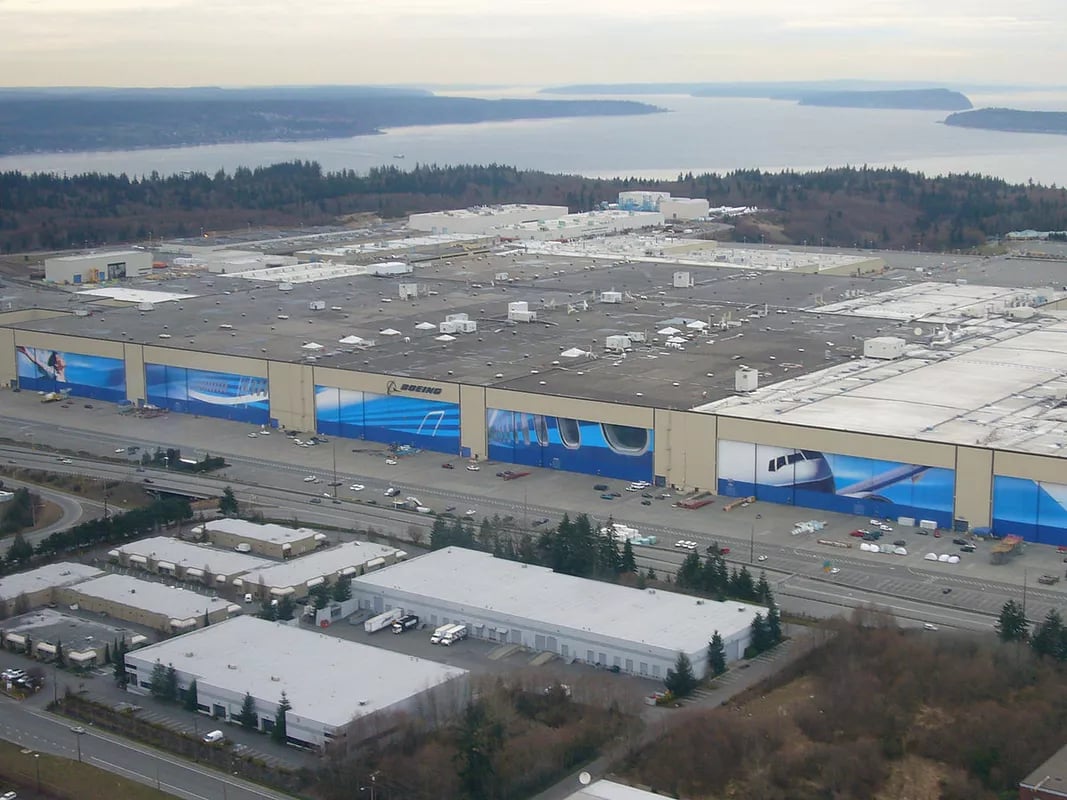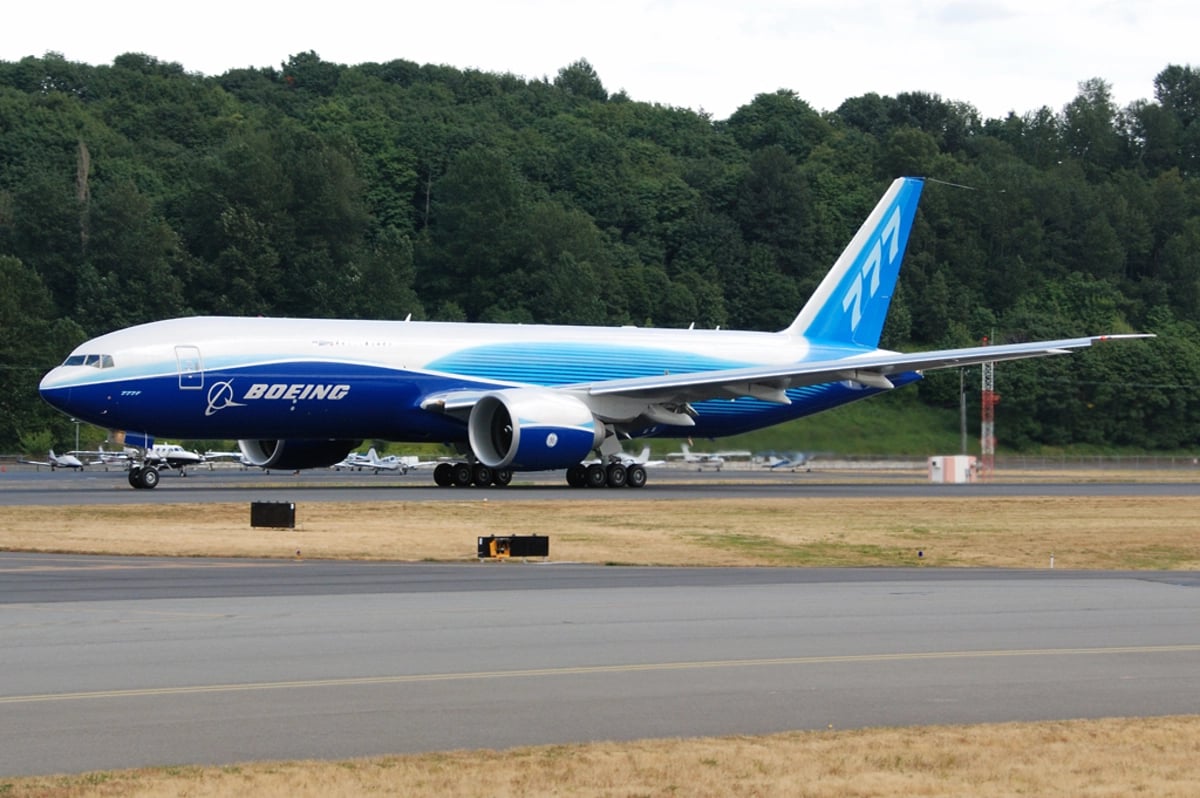What you will find in this text:
- The main aspects of a manufacturing facility
- The Boeing Everett Factory
- Boeing the extra mile: what is expected of the Boeing Everett Factory’s maintenance and facilities professionals?
- Maintenance and asset management at the Boeing Everett Factory
In 1968, the world’s first jumbo jet, the Boeing 747, was produced in Everett, Washington state. Meanwhile, the factory that was built to manufacture it was still under construction. Boeing’s Everett Factory is now the largest manufacturing facility in the world and the largest building in the world by volume – at a whopping 13,485,378 metres cubed.
Let’s take a look inside the factory that pumps out around 800 airplanes a year...
Built on 98.7-acre plot that was formerly an air force base during WWII, the Boeing Everett campus is big enough to cover Disneyland, with about 12 acres of space leftover. More than 35,000 people work there round the clock, now producing new airliners like the 767, 777 and 787. Since the plant opened approximately 3,600 airplanes have been built and delivered to customers all across the globe.
The factory is so huge that even has its own highway – dubbed the Boeing Freeway – so that employees and delivery vehicles can make their way to and from the site. Additionally, there are about 500 tricycles in the factory, used by employees to get across their vast workplace – including 3,000 feet of underground tunnels running underneath the assembly plant. This is no ordinary manufacturing facility...
The main aspects of a manufacturing facility
So, what makes a manufacturing facility like Boeing Everett tick?
Building jumbo jets is not only a huge task in terms of scale but also requires a great deal of precision – Boeing put in a lot of effort to make sure that passengers on their planes are as safe as ever in the skies, something that goes hand in hand with safety at the factory itself. Ensuring a great end product also goes hand in hand with the management of technical equipment and the large workforce working in factories like Everett.
But what makes a factory a factory?
A factory is a highly efficient workplace. Production processes need to be streamlined and designed to ensure optimum productivity This is helped along by specialised technical equipment, at least when maintained and operated correctly.
Transportation is also key, as employees, parts and equipment have to make their way around the facility as and when needed. To top it all off, rigorous safety requirements are also put in place to prioritise workplace safety and prevent accidents.
The Boeing Everett Factory
You might be wondering: How does the biggest manufacturing facility in the world do it?
55 years later and the Boeing Everett factory is still producing airplanes successfully – that's a staggering half-a-century of successful operation. Let’s see how Michael Murray of Boeing’s visitor relations puts it:
“Working three shifts, we operate like a mid-sized city. We have our own fire department, security force. We have a medical clinic. There’s about 500 tricycles in the factory that help people move around more quickly”
In a manufacturing facility as vast as the Everett factory, with employees working round the clock over three different shift times, Boeing had to take a holistic approach, making sure all their employees’ needs were met. This included plenty of services, including:
- A bank;
- A dry cleaner;
- A scheduled bus service.
What DOESN’T the Boeing Everett factory have?
Well, interestingly, one thing the manufacturing facility doesn’t have is air conditioning. Thanks to Washington’s fairly mild climate, workers can simply open the doors and use fans to circulate cool air through the factory. Equally, when it gets a bit too cold, overhead lights shine down and provide heat. For many facilities, HVAC systems (that’s heating, venting and air-conditioning) constitute most of their energy consumption, so solutions like these are a great example of sustainable and environmentally conscious management.

Boeing the extra mile: what is expected of the Boeing Everett Factory’s maintenance and facilities professionals?
In a workplace where rigorous safety requirements must be followed, maintenance and facilities professionals have to make use of predictive maintenance - this involves using technologies, software and data analysis in order to spot problems before they occur. Solving issues before they even happen.
Maintenance and facilities professionals therefore have to stay on top of the data to see how operations are running; for instance, this might include tracking and managing inventory and equipment usage and location. All of this has the ultimate goal of streamlining production processes for greater efficiency as well as refining maintenance scheduling to keep maintenance costs low.
Maintenance and asset management at the Boeing Everett Factory
Utilising computerised maintenance management systems (CMMS) the team at Boeing Everett Factory maintain their equipment in an organised and efficient way.
How does this help exactly?
The Everett manufacturing facility makes use of lots of machinery and equipment with the potential to fail or breakdown. Whether that means a broken part, or another aspect that is slowing down production or even causing the entire production line to fail. These small issues that build up to cause larger problems, are kept under control through the use of CMMS which schedules maintenance checks and assigns them to employees accordingly.
Moreover, process plants that use manufacturing asset management software, like the Boeing Everett Factory, allows them to learn more about their assets so they can manage them correctly. For instance, asset management software helps factories acquire knowledge about their assets, such as:
- Usage;
- Condition;
- Lifecycle.
This enables factories to maximize operational effectiveness and promote business success. Process manufacturing facilities can save expenses, increase production quality and output, and get the most out of all of their assets all with the help of maintenance and asset management.

The Boeing Everett factory is a shining example of how large manufacturing facilities should operate. The way in which the Boeing Everett factory staff look after their assets and carry out maintenance work is incredibly enlightening for anyone concerned with maintenance and asset management.
So, what are the main takeaways to consider from the Boeing Everett manufacturing facility?
- Predictive maintenance is the way to go: at Boeing Everett they understand that complicated equipment and machinery cannot simply be fixed as and when needed; predictive maintenance allows factories to be sure their equipment is checked regularly, therefore mitigating any potential problems in the future;
- Software and predictive maintenance go hand in hand: keeping ahead of the maintenance of equipment is helped along with useful technologies like maintenance software, allowing the team at Everett to keep track of everything.

